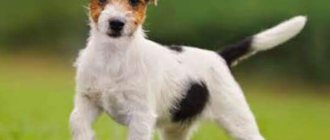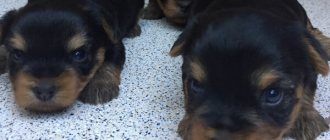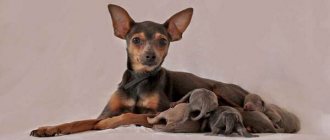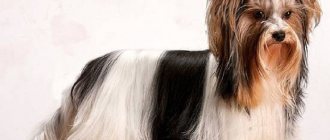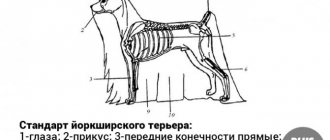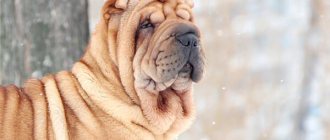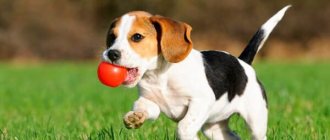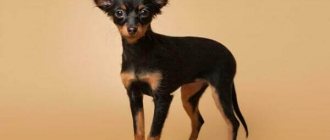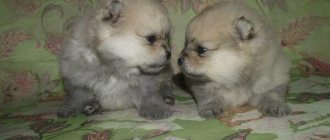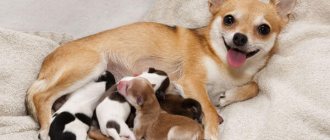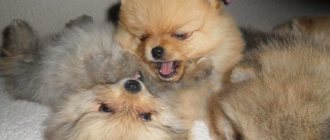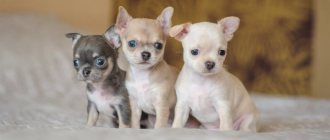Yorkshire terriers are decorative dogs with a lot of positive qualities, thanks to which they have become so popular all over the world.
Yorkies require special care, and this requirement applies not only to adult dogs, but also to puppies.
It is important to understand how the normal development of puppies should proceed, what the weight of the babies should be and when they should be vaccinated, because all these factors are the key to good health and longevity of the dog.
This and much more will be discussed in the article - you will learn how Yorkie puppies develop, how many months they grow and what they need to grow into healthy dogs.. Also here you will find photos with puppies of different ages.
What do newborn Yorkies look like?
Newborn Yorkshire Terrier puppies are born with a smooth black coat and red tan. Their appearance resembles miniature Rottweilers.
A newborn Yorkie has no teeth and his eyes and ears are closed, which means he does not see or hear anything and is guided only by smell.
IMPORTANT!
They have virtually no thermoregulation, so it is necessary to monitor the air temperature - both hypothermia and overheating are detrimental for puppies.
The size and weight of the puppies depends on whether they are standard or mini Yorkshire Terriers. On average, at birth, puppies weigh from 80 to 160 grams.
Prohibited Products
Like all other dog breeds, Yorkies have their own list of prohibited foods:
- boiled bones (especially tubular chicken bones);
- white bread and rolls;
- spices, salt and sugar;
- chocolate products;
- canned food, smoked meats and pickles;
- sausages;
- raw pork;
- River fish.
This is a general list of foods that are harmful to any dog. It is worth consulting with the puppy's breeder, because even when breeding dogs within the same kennel, there may be some deviations and additions.
Growth and development
2-3 days after birth, puppies begin to crawl. At 10-15 days their eyes open, the puppies begin to respond to light, but the retina is still poorly developed.
By 18-21 days, Yorkie babies develop a fat layer, thermoregulation appears, and they begin to respond to sharp sounds.
On days 20-24, teeth begin to erupt, and by this age the puppy begins to hear.
By the month the puppies' activity increases, they leave their “playpen” and get acquainted with their surroundings.
At 8-9 months, the change of teeth ends, and the dog begins puberty. By this age, the Yorkshire Terrier reaches its maximum height, but is still developing.
In the first months of life, puppies develop as intensively as possible; it is important to monitor weight gain in order to understand that the puppy is eating correctly and is not underweight or overweight.
Yorkie puppies weight table by month:
| Age | Micro | Mini | Standard |
| Birth weight | 80 gr | 115 gr | 160 gr |
| 1 month | 230 gr | 370 gr | 595 g |
| 2 months | 370 gr | 610 gr | 940 gr |
| 3 months | 540 gr | 850 gr | 1280 gr |
| 4 months | 710 gr | 1110 gr | 1680 g |
| 5 months | 850 gr | 1300 gr | 1990 gr |
| 6 months | 940 gr | 1450 gr | 2210 gr |
| 18 months | 1140 gr | 1820 gr | 2730 gr |
As adults, standard Yorkshire terriers reach a height at the withers of 22-24 cm, mini - 16-18 cm, micro - up to 15 cm.
Baby teeth
Yorkie is 4 months old his baby teeth are starting to bother him . They will be replaced by permanent teeth before the age of one . It is at the age of 4 months that you should start monitoring your puppy’s jaw - play a lot so that the teeth loosen faster, examine the jaw daily for swelling and wounds.
Important! If you see that a molar tooth is growing on a baby tooth, then you need to go to the veterinarian.
Types of puppies
A litter born from two standard representatives of the breed may produce standard puppies or the so-called mini, super-mini and baby-face Yorkies, which differ from the standard ones in weight and have a shorter muzzle with an upturned nose.
Also, puppies can belong to such varieties of Yorkshire terriers as Russian Saloon, Goldust, Chocolate or Biro, but this can only happen as a result of targeted breeding work .
Vices of non-standard dogs
Representatives of the breed that do not meet the standard have a lot of health problems. So, in Yorkies that are too light, the following are most often observed:
- Hypoglycemia.
- Drowsiness, lethargy, lack of coordination of movements caused by hypoglycemic shock.
- Digestive problems.
- Periodontal disease.
- High probability of fractures.
- Joint diseases.
- Dislocation of the kneecap.
- Tracheal collapse.
- Otitis.
- Cryptorchidism.
- Non-overgrowing fontanel.
- Legg-Calvé-Perthes syndrome.
- Intolerance to anesthesia.
Also, female mini or micro Yorkies are not allowed to breed - they cannot bear and give birth to healthy puppies on their own. To get small puppies, standard females are mated with small males. The structural features of the Baby Face Yorkie's muzzle are the cause of chronic conjunctivitis (due to a narrow tear duct and frequent eye injuries) and breathing problems, which is why the dog can “grunt” while moving and snore.
The life expectancy of non-standard representatives of the breed is much lower: 10 - 12 and 7 - 9 years for mini and super mini Yorkies, respectively.
How to care?
During the first weeks of life, the puppies are looked after by a bitch - she feeds them, turns them over, and constantly licks them. The breeder must only ensure that the puppies do not become hypothermic or overheated, and that the bitch does not accidentally crush them.
On the 3-5th day, they need to remove the dewclaws, if any - you need to stretch the skin on the puppy’s paw and quickly cut off the extra toe with sharp office scissors, and then cauterize the wound with potassium permanganate.
NOTE!
At this age, puppies do not yet react too much to pain and if the procedure is carried out correctly, they will not react to it in any way.
Around the 5th-6th day, you need to trim the nails so that they do not hurt each other or the belly and nipples of the bitch during feeding.
Puppies should not be bathed until they are 3 months old, but they must examine their eyes daily and wipe them with chamomile infusion or a special lotion.
At about a month, when the coat is quite long, the puppies need to have a hygienic haircut - use a special clipper to trim the hair in the groin area, near the genitals and anus. It is also necessary to free the upper third of the ears from fur so that they do not bend under its weight and acquire the vertical position required by the breed standard.
At the same age, you should begin raising puppies, accustoming them to a diaper or tray.
When the Yorkshire Terrier grows up and is vaccinated, he should be walked every day - this is necessary not only for the physical health of an active and energetic dog, but also for its socialization and the formation of a stable psyche.
After each walk, you need to thoroughly wash your paws and belly, and give your pet a full bath about once every 3 weeks.
You should also brush your dog daily to prevent its fur from getting tangled, and monitor the condition of its teeth, mouth, and ears.
Breed characteristics of Yorkies
Yorkshire Terriers are small dogs, with an average weight of 2-3 kg, and a fairly early development. Yorkies have a long coat, without undercoat, with a hair-like structure. Dogs of this breed have an accelerated metabolism - they quickly burn energy, which requires compensation with high-calorie food. Particular attention should be paid to this during the period of growth and development.
Such breed characteristics are the cause of “eternal hunger” in Yorkies - having quickly used up the energy received from food, they want to eat again . And this is precisely the main mistake of inexperienced owners who rush to compensate for their pet’s hunger with too frequent meals.
Remember! The Yorkie's diet is not too different from other dog breeds if the puppy receives high-calorie food in its diet with a sufficient content of meat ingredients and easily digestible carbohydrates.
Establishing the feeding behavior of any dog begins with organizing a place for feeding.
Feeding the puppy
During the first weeks of life, the diet of Yorkshire Terrier puppies includes only mother's milk.
When the puppies are 3 weeks old, you should begin introducing complementary foods consisting of preheated milk, lean meat, cottage cheese or kefir, but not more than 2 tsp. in a day.
At the age of 2-3 months, low-fat sea fish, vegetables (beets, bell peppers, pumpkin), green apples, offal, and boiled cereals should be added to the puppy’s diet.
IMPORTANT!
All new foods must be introduced into the Yorkshire Terrier's diet gradually, carefully observing how the pet reacts to them.
Food for a puppy should be at room temperature or a little warmer and cut into small pieces, and if the pet is less than 3 months old, crushed to a puree.
If your puppy's diet consists of ready-made dry food, the brand should be designed specifically for Yorkshire Terrier puppies.
The diet can be free, but Yorkies are prone to overeating and obesity, so it is better to organize the diet depending on the age of the puppy:
- up to 2 months – 6 times a day;
- 2-3 months – 5 times;
- 4-5 months – 4 times;
- 6-12 months – 3 times.
A one-year-old dog needs to be fed 2 times a day - morning and evening.
The serving size is calculated based on the dog's weight - 1-2 tbsp. for every 500 grams of weight.
The puppy should always have access to clean water. It should be soft (settled or filtered); hard water can cause Yorkie urolithiasis.
"Moscow talisman"
from 4 to 6 months:
From the book by I. Manina “Yorkshire Terrier. Choosing and raising a puppy”, excerpt.
Experts have found that if puppies from 3 to 6 months were raised only by people and did not see dogs, then they become hyperexcitable and do not develop parental and sexual instincts. Such dogs have difficulty learning and quickly forget what they have learned. Remember that even the smallest Yorkie is still a dog. You don’t need to be too protective of your puppy, but you can’t be too strict with him. Teach your child everything he can learn at his age, take him for walks, give him the opportunity to meet different representatives of the animal world and strangers. The more your Yorkie sees and learns, the more intelligent and balanced he will be.
PERIOD OF TEETH CHANGE IN A PUPPY. Let's consider a standard situation: a puppy up to 5 months old was very clean, but suddenly, out of the blue, he started peeing all over the apartment. The owners decide that he is mischievous and is taking revenge on them for leaving the house. What should I do? Animals are not familiar with such feelings as revenge or “acting out of spite.” This is the prerogative of man. You should not attribute human negative qualities to a dog. Animals obey their physiological needs, that’s all. If a dog's bladder becomes full, it will empty it. If you have created conditions for reinforcing positive behavior skills, maintaining cleanliness, and the dog has established a cause-and-effect “did-received” relationship, then rare mistakes can be corrected or forgiven. Just develop the correct reflexes in your puppy. I hope that in the first months of being in your apartment, you constantly rewarded your puppy with affection or treats for the correct “hits” on the diaper? In Yorkie puppies, at 4-5 months, a difficult period begins - changing teeth. At this time, as a rule, the puppy feels general malaise, his gums hurt and itch. He becomes irritable, chews everything, sometimes falls into a state of early puppyhood, when the basic skills have not yet been consolidated, but are only in the stage of formation. For the same reason, he cannot control his bladder and bowels. Veterinarians warn owners of puppies of this age that during the period of teeth change, immunity decreases, the dog becomes more susceptible to infections and all vaccinations and stress are contraindicated for it, including psychological ones (training, travel). Therefore, the main rule of the owners during this period of crisis for the puppy is to be friendly and create conditions for the puppy in which the possibility of wrong actions is reduced. For example, if earlier the puppy carefully ran around in the diaper, even in your absence and when moving freely throughout the apartment, now it is necessary to limit its freedom. Close all the doors in the room, give the puppy one room or kitchen where he can run out only with your permission and in your presence. Take the puppy to the diaper more often (especially after sleep), be sure to praise him for the correct “hit”. This way you will remind your baby of the necessary skills. Very little time will pass, the teeth will change, the body will cope with the stress and everything will return to its place. Cleanliness in your apartment will be maintained if you follow these simple rules. What if the apartment has no doors? Then you will need to place the puppy in an enclosure. For one Yorkie, an enclosure with a length of 1200 cm and a width of 60-80 cm is sufficient. Place a bed in this space, and a toilet on the opposite side. Place a few toys, a chewing bone, and a ceramic bowl of water in the enclosure. In such conditions, it will be easier for the puppy to navigate in your absence. When you return home, do not rush to let the puppy out. Do this after you see the results of his correct “hit” in his “toilet”. To perform this “good deed”, 15-30 minutes are enough. During this time, you will have time to go to the bathroom, change clothes, and prepare food for the puppy. Now - let it out! Play with him for a while, and then put him back in the enclosure and feed the baby. After instantly absorbing a portion of food, do not rush to release it, let him visit the toilet one more time (this is necessary for the puppy’s body after eating). About walks .
If you decide to accustom your Yorkie to walks and “toilet” only outside, be pedantic. Every day, at the same time, regardless of the weather, weekends and holidays, go out into the yard with the puppy. Dogs do not differentiate between weekdays, when the owner needs to get up early, and weekends, when they can sleep longer. The dog’s body gets used to cleansing itself at the same time - remember this. A clear and consistent routine ensures cleanliness in your apartment. Rewards for the desired behavior should be regular, especially in the initial period of learning to walk. And don’t neglect the opportunity to include all family members in walks with the puppy. To avoid any resentment, make a schedule for walks or divide responsibilities. For example: dad feeds him in the mornings and evenings, mom feeds him during the day, and the children take him out for a walk, and if the puppy couldn’t resist or, having returned from a walk, brought “all his own” to the apartment, they clean up after him. This way, you can not only maintain order in the apartment, but also instill in your children a sense of responsibility, which will be very useful to them in life. Command "CLEAN!" All Yorkshire puppies are clean from birth. If the breeder supports the children’s aspirations for cleanliness and reinforces this positive quality in each puppy, then the adult dog will not have problems with cleanliness. To do this, breeders need to follow simple rules: 1. Raise puppies in a spacious enclosure. 2. Divide the enclosure into two zones, using most of it as a latrine, covering the floor with newspapers. Set up a small sleeping area in another area. 3. Starting from the 15th day, every time the kids wake up, move them to the “toilet” area and wait for them to make “puddles”. Pet and praise for exemplary behavior, saying “clean - clean”, and then put them in a sleeping place and let the mother visit the puppies as a reward. Very quickly, children will begin to independently cope with the important task of finding a toilet. How to raise a clean person.
All animals are very clean and only humans make them dirty. For example, a pig is actually just the cleanest among four-legged animals. But locked in a cramped barn, and even with owners who do not bother themselves with daily cleaning, the pig, willy-nilly, becomes something that is shamed for children and puppies. The same thing happens with our dogs. Anyone who wants to teach a dog to be clean must comply with two conditions: make it clear to the puppy, firstly, in what place he should do his “business” and, secondly, that he will be given the opportunity in time to perform his natural needs there. A small puppy is not able to endure it for a long time; it is even contraindicated for him. The desire to empty the intestines or bladder quickly becomes a truly dominant need - that is, the most important necessary, super-main, inhibiting and excluding all other needs until it is satisfied. Therefore, there is no point in punishing a small puppy; it will not give anything. Don't rub your puppy's nose into what happened. You consider this kind of poking “punishment”. And from the dog’s point of view it is natural. You yourself may notice that on walks dogs carefully sniff excrement and puddles of urine, while receiving a lot of important information about their source. It is easy to train a puppy in a specially designated area. However, you should hurry! The puppy does not know about your plans for arranging his toilet room. If you are late in explaining where it is, he will choose a “place” of his own choosing. The technique of training a dog to such a place is simple. As soon as you notice the puppy's specific behavior, carry him there in your arms. Don't let him escape from this place before his needs are met. Be prepared for possible resistance from the puppy and the fact that he will not always hit the “target”. It takes time to learn. And don’t skimp on rewards for correct behavior and hitting the “goal.” For the first few days, do not let your baby Yorkie wander around the entire apartment. The puppy will simply get lost and will not find his “toilet.”
First vaccinations
Mother's milk protects newborn puppies from infections and diseases. When the feeding period ends, this protection disappears and is replaced by immunity developed by the puppies on their own.
Vaccinations are required to develop the immune system.
Any vaccination has several basic rules:
- It is prohibited to vaccinate a pregnant or lactating bitch;
- You should not vaccinate too early, otherwise it will not work and the risk of infection will increase;
- the same drug should be used for vaccination and revaccination;
- the puppy must be completely healthy.
CAREFULLY!
Vaccinating a sick or weakened pet after an illness can cause death.
In addition, 7-10 days before vaccination it is necessary to carry out deworming, and the dog cannot be bathed a day before the procedure.
The standard vaccination schedule includes vaccinations against rabies, hepatitis, parvovirus gastroenteritis, distemper and leptospirosis.
Vaccination schedule:
- 1st vaccination – 8-9 weeks;
- revaccination – 10-11 weeks;
- 3rd vaccination – after changing teeth, approximately 7.5-8 months;
- rabies vaccination – 3-4 months and a year.
In the future, the Yorkshire Terrier must be vaccinated annually at the same time.
The owner chooses the vaccine for vaccination himself (usually Eurikan or Nobivak), and notes on the vaccinations performed are made in the veterinary passport.
A slight increase in temperature and refusal to eat after vaccination is a normal reaction of the body.
How to bathe properly?
Before bathing your puppy in the bathtub or sink, you need to lay a rubberized mat so that the pet does not slip. You should use shampoo and conditioner that is appropriate for your coat type and will make it easier to comb, and the water should be at room temperature.
The shampoo should be rubbed in your palms, mixed with water, lathered on the dog and rinsed off, repeating all this twice. Then apply conditioner, leave it on the coat for 2-3 minutes and rinse.
When bathing, you need to make sure that water does not get into your Yorkie's ears - it is better to cover them with cotton swabs.
After bathing, wrap your pet in a towel, then dry the coat with a hairdryer and comb it.
You can bathe the puppy only after a two-week quarantine has passed after the 2nd vaccination, i.e. at about three months of age.
Choosing a place and dishes
This issue should be resolved before the puppy arrives in the house, and it is correct if the chosen place for feeding does not change in the future. Since these small dogs do not require large areas for their “table,” bowls can also be placed in the kitchen. For food and water you need separate dishes that need to be washed regularly.
It is better to choose dishes made of stainless steel - this is the optimal price-quality ratio, but you can also buy plastic and ceramic ones. The bowl is selected so that a single portion of food occupies approximately 2/3 of its volume. Since puppies turn over plates when feeding, it is worth purchasing a special mat on which the bowl will not “slip.”
Special devices are very convenient for feeding - rods, table tops with holes. All these attributes are sold in pet stores, and a consultant will help you decide.
The so-called ball drinker, otherwise called “dry whiskers,” has become very popular, designed specifically for bearded and mustachioed dogs. With such a device, you can safely leave your dog for the whole day without worrying that he won’t have enough water.
Changing and brushing teeth
The change of teeth from milk teeth to molars in Yorkies begins at 3.5-4 months and should be completely completed by 8-9 months, maximum by 1 year.
During this period, the puppy should be given toys that are easy to chew and special treats to help the teeth loosen faster.
IMPORTANT!
If a molar grows next to a missing baby tooth, or if a wound or swelling is found in the puppy’s mouth, you need to show your pet to a veterinarian.
Due to the special arrangement of teeth, food debris often accumulates between them, which needs to be cleaned out with a toothpick.
In addition, Yorkshire terriers are prone to plaque and the formation of stones, so you need to brush your pet’s teeth 2-3 times a week with a special paste and brush sold in pet stores, and conduct a thorough cleaning at the veterinary clinic twice a year.
Yorkshire Terrier puppy care and education
Since the Yorkshire Terrier is an indoor dog , it rarely goes outside. Therefore, the animal will go to the toilet in a tray or on a diaper. The question of training a pet to use a litter tray arises before puppy owners approximately from the moment the baby turns one month old . If the mother is nearby, the puppies will learn from her, and the training process will go smoothly.
If the baby doesn’t want to go to the toilet where you decided to put the diaper, then observe where the pet most often leaves puddles, and that’s where you put the diaper.
Puppies empty their stomachs when they wake up or after eating. Notice this, the dog begins to sniff the floor. Take the puppy and put it in the tray .
If everything went well, praise your pet and give him a treat. This procedure must be performed every day for several weeks, then the dog will learn to go to the litter box without problems.
Or make the puppy’s movement area small, lay a diaper there or place a tray. If your Yorkie goes to the toilet while wearing a diaper, praise and treat.
If not, then plant it there every time, day after day, and success will come!
Advice! If your baby defecates past the tray or in another corner of the room, do not scold him under any circumstances! It is necessary to explain with strict intonation immediately after visiting the toilet that you need to use the litter box.
When is weaning from the mother?
You need to take into account the condition of the bitch and the behavior of the puppies - when the puppies are cutting teeth and growing claws, the bitch may experience unpleasant and painful sensations during feeding. This indicates that it is time to wean the puppies.
Most often, puppies are separated from their mother when they are 50-60 days old. Moreover, if the bitch has problems with lactation and there is not enough milk, this can be done at 3 weeks.
The most interesting
Many of those who are planning to get a dog think about Yorkies. But for some reason they buy a dachshund or a labrador or... No one. Some people simply didn't have enough money. And some hunter, thinking that such a little thing was not able to cope with a fox, a wild boar, and especially a bear, got a larger hunting dog.
How often will Yorkies be an indicator of wealth. But still, the majority of those who choose this puppy want him, this hooligan and shaggy one.
Take the Attention Test! Find 10 differences! (click right here!)
Find the answer Are you bothered by some problem or question? Enter “Breed” or “Name of the problem” into the form, press Enter and you will find out everything about the issue that interests you.
These little dogs have the courage of a terrier, they are cheerful, beautiful, will fit in a small handbag, will gladly accept a collar hung with diamonds, and will allow you to tie the most unimaginable bows on your head.
Yorkie puppies at 2 months old cost a lot of money. Anyone who decides to make such a purchase should take good care to ensure that this dog grows up healthy and does not harm the pet.
How to choose a puppy?
First of all, you need to choose a trusted nursery and conscientious breeders - this will minimize the risk of buying an unhealthy puppy. In the kennel, you need to pay attention to the living conditions of the dogs, find out about the puppy’s parents and their health. The breeder must answer all questions and present all necessary documents.
A healthy puppy should be active, friendly and curious, be able to feed itself, and have:
- black, cold and wet nose;
- dark eyes, without discharge and increased lacrimation;
- the stomach is not bloated;
- the coat is soft, thick and shiny, without bald spots;
- skin without peeling, rashes or signs of irritation;
- each jaw has 2 canines and 6 incisors, scissor bite.
The puppy must also have a veterinary passport with deworming and vaccination records.
